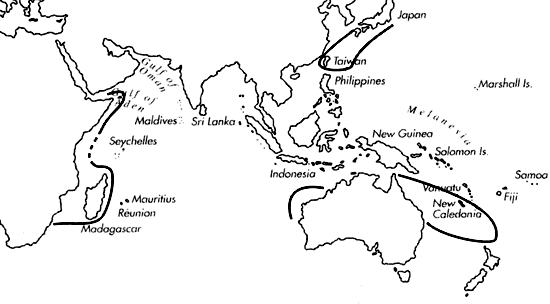Range: Natal and Madagascar to Somalia, Japan to Taiwan, N. of New Zealand, Queensland, and W. Australia.
Description: Moderately large to large, moderately solid to solid. Last whorl conical or ventricosely conical,voccasionally slightly pyriform; outline varies from almost evenly straight to convex at adapical three-fourths and concave below. Shoulder broadly carinate, may havevdensely set rounded tubercles in smaller adults. Spire usually of moderate height and stepped, outline slightly concave to slightly convex. Postnuclear spire whorls carinate, with closely spaced rounded tubercles in first 5-10vwhorls. Teleoconch sutural ramps flat to concave, with numerous spiral grooves or spiral striae; sculpture eroded on early ramps. Last whorl with prominent or sometimes weak spiral ribs on basal fourth and closely set spiral striae above.
| Shell Morphometry | ||
|---|---|---|
| L | 55-111 mm | |
| RW | 0.13-0.50 g/mm | |
| (L 55-105 mm) | ||
| RD | 0.51-0.58 | |
| PMD | 0.81-0.93 | |
| RSH | 0.11-0.22 | |
Colour cream to orangish tan (shells from Somalia, Pl. 26, Figs. 4,5), sometimes axially streaked with darker and lighter shades. Aperture orange.
Periostracum olive-brown, rather thin, opaque, with finevaxial ridges.
Operculum long, elongately ovate to pisciform, deeply scalloped or toothed on right side.
Habitat and Habits: Occurs primarily at continental slope depths. Japanese and Taiwanese shells have been trawled in 250-360 m, Australian specimens are reported from about 450 m, N.W. Madagascar specimens from 550 m, and specimens from New Caledonia in 435-675m. Specimens collected by the Valdivia during the Deutsche Tiefsee- Expedition came from depths as great as 1134 m.
Discussion: C. teramachii resembles C. sieboldii and C. gradatulus Weinkauff (see Vol. 2) most closely. For comparison with C. sieboldii, see the Discussion of that species. C. gradatulus generally has a broader last whorl (RD ca. 0.55-0.64), bears only weak to obsolete spiral striae on its sutural ramps, and lacks carinate postnuclear whorls with distinct rounded tubercles; it does not have toothed operculum and often has brown axial blotches on the last whorl.

C. teramachii range map
This section contains verbatim reproductions of the accounts of 316 species of Conus from the Indo-Pacific region, from Manual of the Living Conidae, by Röckel, Korn and Kohn (1995). They are reproduced with the kind permission of the present publisher, Conchbooks.
All plates and figures referred to in the text are also in Röckel, Korn & Kohn, 1995. Manual of the Living Conidae Vol. 1: Indo-Pacific Region.
The range maps have been modified so that each species account has it own map, rather than one map that showed the ranges of several species in the original work. This was necessary because each species account is on a separate page on the website and not confined to the order of accounts in the book.